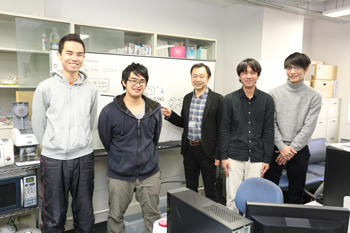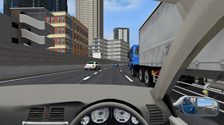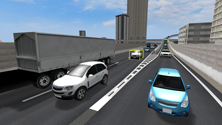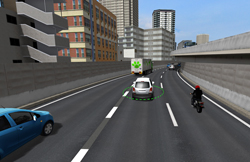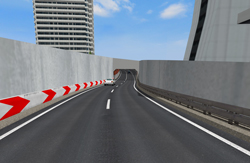Academy User vol.11
Shibaura Institute of Technology
Advanced Driver Assistance Systems Laboratory Department of Machinery and Control Systems College of Systems Engineering and Science
Analyzing Driving Characteristics, Optimum Assistance by Means of Systems and Provision of Information Investigated
With Research on Biological Reaction During Autonomous Driving in Consideration, Traveling Is Reproduced Using UC-win/Road DS
URL ● http://www.web.se.shibaura-it.ac.jp/tosi-ito/
Location: Saitama-shi, Saitama Pref.
Research contents: correlation of a driver's unconscious driving behavior and biological reaction / development of robots operated by full autonomous driving
"Our Lab proposes plans on the future of automobiles. I believe use of driving simulators (in those proposals) will make it possible to show such future concretely, or verify that the (proposed) driver interface works well through experiences (of users)".
Professor Toshio Ito, Dr. Eng., Department of Machinery and Control Systems, College of Systems Engineering and Science, Shibaura Institute of Technology, used to be engaged in various research and development on automobiles including driver assistance systems for long years when he was working in an automobile manufacturer. Making the most of knowhow and knowledge accumulated there, he puts weight on his own original analyses and researches from an academic point of view towards the "autonomous driving" society to come.
His statement above is about his own stance on research and the possibilities to be brought about by the use of simulators in his research.
| It is about 5 minutes by school bus frequently commuting between the Higashi-Omiya Station of JR (Japan Railway) and the Institute. Passing through the Institute gate, which has just been installed at the opportunity of 50th anniversary of the opening of the Omiya Campus of the Institute (1966), visitors are led to the group of school buildings among well-balanced arrangement of clump of trees on a street called "Green Campus". One of these buildings accommodates "Advanced Driver Assistance Systems Laboratory (Ito Lab)" and "Laboratory" that houses simulators. Seen from the passage that connects them, small wood with autumn leaves were very impressive through a wide windowpane on the upper side of the main stairs. | ||
|
Since Prof. Ito arrived at the Institute 4 years ago, he was often faced with restriction of the old simulator he took over from his predecessor while he was proceeding with the research mentioned above. He came to adopt FORUM8's "UC-win/Road Drive Simulator (DS)" (2016) to break through towards new research challenges in particular. |
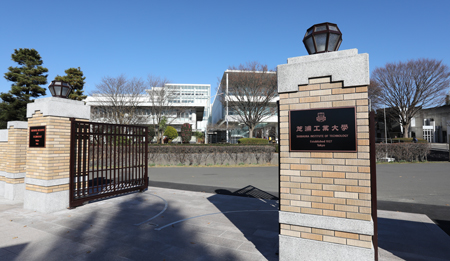 |
|
Positive Utilization of ICT to Investigate Advanced Driver Assistance
It was in the spring of 2013 that Prof. Ito arrived at Shibaura Institute of Technology. Up until then, in Daihatsu Motor Co., Ltd. where he had been working for more than 30 years, he took charge of diverse research and development related to automobile. As part of this, he was also involved in development of pre-crash safety system, which he describes as "the early stage of the uncrashable car of the recent trend", as the first case for light automobiles.
"There are many restrictions (on research and development) in a company, for example, products come first." In other words, even if the system that attracts attention is valuable, it is not necessarily adopted unless it suits the car. It was expected that the Institute could shed light on such fields from an academic point of view. However, it is not easy to actually develop a product or conduct required test-driving just as automobile manufactures. Thus Prof. Ito freely used excellent application software programs and DS. While putting weight on analyses and researches on drivers' reaction during the ride as well as interfaces with the driver during autonomous driving, he has also started to study on realizing a robot capable of full autonomous driving, applying sensing technologies related to autonomous driving.
The precursor of the Institute, Tokyo Higher School of Industry and Commerce was founded in 1927 in Omori, Tokyo. After repeated reorganization and movement and the post-war educational reform, the current Shibaura Institute of Technology was founded in Minato-ku, Tokyo, in 1949. In 1966, in addition to Shibaura Campus, Omiya Campus was opened (in current Saitama city, Saitama). In 1991, College of Systems Engineering was established, in which Department of Machinery and Control Systems was set up. Then Toyosu Campus was opened in 2006, and Shibaura Campus was reopened in the old Shibaura Campus in 2009 respectively. College of Systems Engineering was renamed College of Systems Engineering and Science in 2009.
| Currently the Institute consists of 3 Colleges: College of Engineering (11 Departments), College of Systems Engineering and Science (5 Departments), and College of Engineering and Design (1 Department). It also has Graduate School (2 Schools). Over 8,000 undergraduate and graduate students in total are learning in 3 Campuses of Toyosu, Omiya, and Shibaura. | ||
|
|
In "Department of Machinery and Control Systems, College of Systems Engineering and Science" where he belongs, students learn machinery and control systems such as high-functional robots, automobiles of next-generation and clean energy, with an approach of system engineering to relate academic fields to each other in a cross-sectional way as its core. In particular, Advanced Driver Assistance Systems Laboratory that Professor Ito takes charge of investigates systems and information provision methods that lead to the optimum assistance in terms of efficiency, comfortableness, and safety by analyzing drivers' driving characteristics based on automotive engineering. The Lab accommodates 27 graduate and undergraduate students in total at present (three of them are from abroad). It is one of the characteristics of the Institute that there are many students from abroad coming from Asian universities allied with the Institute. |
|
With Autonomous Driving in Consideration, Unconscious Behavior of the Driver and Advanced Mobility Focused on
Since he started to work on Advanced Safety Vehicle (ASV) promoted by Ministry of Land, Infrastructure, Transport and Tourism (MLIT) while he was working in the automobile manufacturer, Prof. Ito has been deeply involved in diverse researches on "uncrashable car". In parallel with this, he served as a Japanese representative of TC204/WG14 that deals with standardization of Cooperative Vehicle-Infrastructure Systems related to travelling control in a technical committee on ITS (Intelligent Transportation Systems) as a committee member of ISO (International Organization for Standardization). As such, he is well informed about the advanced trend of the industry. In such circumstances, the world of "changing automobiles by driver assistance" has been set to his new target as an academic researcher.
One of the specific subjects is the analysis of "conscious-like part of unconsciousness of a human being". This is based on the idea that a driver's operations of the steering wheel or brake are mostly performed unconsciously according to the previous learning. In recent years, though development for aiming at autonomous driving is enlivened, it is considered to take more time to realize full autonomous driving. Until then, it must be necessary to switch to human (manual) operation depending on the circumstances. Therefore, it was considered to be important to know about the driver's unconscious reaction and behavior, and interfaces with the vehicle.
| Another one is development of full autonomous driving robot. In autonomous driving of automobiles, development proceeds step by step from the driver assistance system to the driving system that requires switching to human operation, to the support for traveling on the expressway and to that on the general road. It means that it may take still more time until this benefits mobility scooters for senior people or electric wheelchairs used by the senior or disabled people who need autonomous driving most. Consequently, development of full autonomous driving for mobility scooters by the Institute is conceived. | ||
|
On the other hand, the Institute employs many researchers who work on various domains related to automobiles. They are acting individually, divided into three campuses. To have such researchers in the Institute connected together, Professor Ito organized "Advanced Automobile and Mobility Consortium (ADAM)" in 2014. Holding up "Aiming at creation of new value of mobility for 21st century" as its concept, the program of presentation is conducted in spring and autumn every year. Next presentation is planned in March 16, 2017 at Omiya Campus, having lectures by guest speakers on autonomous driving (under negotiation with automobile manufacturers), research presentation by faculty members and students of the participating laboratories, and test drive of UC-win/Road DS etc. |
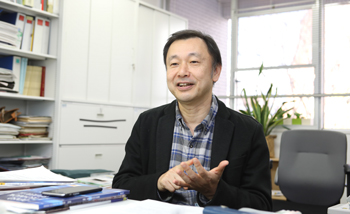 |
|
Introduction of UC-win/Road DS and the Current Aim of Experiments
"When I was involved in traffic jam, I used to think "That's what I expected; It has come to traffic jam after all," since long ago. I was thinking that I was probably sensing advance warning unconsciously."
He remembers the background for starting with research on the driver's unconscious behavior right after arriving at the Institute. Thus he firstly created the state of premonitory signs of traffic jam using old DS he had taken over from his predecessor, then analyzed the driver's operation of steering wheels and pedals. He investigated the difference between the state without traffic jam and the state with premonitory signs of traffic jam.
In these processes, he recognized the usefulness of DS over again. However, the existing DS had a restriction that it was not capable of creating a new course by itself and that it was only able to drive on the determined courses. As a result, in creating a new course, it was required to create it using application software of CG from a scratch separately and load it into DS. Low efficiency of production became a problem.
Around that time, he took part in the alumni reunion of senior high school (Hyogo Prefectural Nagata High School) held in Tokyo in 2014. At the venue he happened to take a seat next to FORUM8 President Ito, who let him know about UC-win/Road DS.
It made an impression that it suits to his research purpose and could lead to the solutions for problems of existing DS.
As he could get budget in 2016 fiscal year, Adoption of DS was examined. In August, UC-win/Road DS of two-axis motion platform was adopted.
On the assumption that it would be "autonomous driving with switch to and from a human being" for the moment, he set up the research purpose to conducting judgment to determine whether the driver is in such conditions as to be able to monitor external environment by analyzing the driver's biological signals. As tools for this, he considered using DS and actual vehicles to conduct autonomous driving. However, since the experiment of autonomous driving using an actual vehicle cannot be conducted independently, he first prepared DS that mounted the course reproducing the Tokyo Metropolitan Expressway. Using this, experiments were performed to give various tasks and challenges to drivers travelling by autonomous driving, from which biological reactions such as brain waves and cerebral blood flow were observed. An approach was planned to investigating, when the use of actual vehicles becomes possible, whether there is correlation between the experimental results and the driver's conditions, and what is the difference if any.
Then in the Lab, Mr. Akihiro Abe, Senior student of Department of Machinery and Control Systems, College of Systems Engineering and Science learned the basic way to use UC-win/Road and created a course to represent the actual Tokyo Metropolitan Expressway Ring Route after about one month' work. In the future, Prof. Ito is planning to extract and organize diverse issues in the following viewpoints: 1) provision of information that may interest the driver, 2) provision of traffic information and advice around the driver's vehicle, and 3) request for tasks of low burden to avoid sleepiness.
Future Development and Expectation Towards DS
Regarding development on autonomous driving of the mobility scooter mentioned above, Prof. Ito conceived not only a single project of his own lab but also a joint project through ADAM. One of the ideas is collaboration with other laboratories that are developing network robots, to work towards 2020 when Olympics and Paralympics will be held in Tokyo. He is planning an event of arranging multiple network robots that mount the autonomous driving function in the bay area with Toyosu Campus as its center to guide visitors from abroad.
Concerning autonomous driving of network robots and mobility scooters for senior people, it is also necessary to consider the scenes of moving in and out of buildings seamlessly. Moreover, in recent years, there is an upsurge of research and development on BMI (Brain Machine Interface) technology, which uses brain information by connecting the brain with machine directly. Prof. Ito also keeps application of this technology to the process of observing the driver's biological reaction in mind.
On the other hand, researches for such fields also require support for different kinds of representation that were not found in existing DS. "It's easy to create a new course, and the quality of images is very satisfactory," says Prof. Ito, highly evaluating the DS he has adopted. He also expects possibility of utilizing it in a more expansive way to adapt to their future activities.
(Written by Takashi Ikeno)
